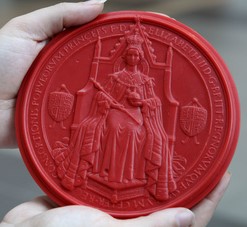Great Seal of Scotland

The Great Seal of Scotland (Scottish Gaelic: Seala Mòr na h-Alba) is a seal used by the first minister of Scotland to seal letters patent signed by the monarch giving royal assent to bills passed by the Scottish Parliament. The Great Seal of Scotland is the principal national symbol of Scotland that allows the monarch to authorise official documents without having to sign each document individually.
Wax is melted in a metal mould or matrix and impressed into a wax figure that is attached by cord or ribbon to documents that the monarch wishes to make official. The earliest seal impression, in the Treasury of Durham Cathedral, is believed to be the Great Seal of Duncan II and dates to 1094.
The first minister of Scotland is the current keeper of the Great Seal of Scotland and it is considered as one of the highest honours of the office of the first minister.
| This article is part of a series within the Politics of the United Kingdom on the |
| Politics of Scotland |
|---|
 |
History
[edit]Kingdom of Scotland
[edit]In the Kingdom of Scotland, an independent sovereign country, the chancellor of Scotland had the custody of the King's Seal. [1] The register of the Great Seal of Scotland is Scotland's oldest national record having served as a means by which the Monarch signs official documents in Scotland and documents relating to Scots law for over 700 years.[2]
Following the Union of the Crowns, the seal was adapted under the reign of James VI and I (James VI of Scotland, and James I of England and Ireland). The seal was first used in 1603 until 1605 and notably featured a change of coat of arms on the seal. The coat of arms featured on the Great Seal under James VI contained the arms of both Scotland and Ireland and also featured differences to the legend which featured on the seal. Such changes were an indication of the union with Scotland, England and Ireland under one monarch as a result of the Union of the Crowns which came into effect in 1603.[3]
During the period which Scotland was under the Commonwealth (1652–1660), the Great Seal was changed to depict Oliver Cromwell who was the Lord Protector of the Commonwealth. The seal depicted a Cromwell equestrian figure with with long hair and wearing a sash and armour. On the reverse side, a view of troops with a landscape in the background was featured. The Coat of Arms of Scotland featured on the seal with English language inscriptions.[4]
Treaty of Union and devolution
[edit]
Strictly, the continuation of the Great Seal of Scotland was guaranteed by the Treaty of Union which provided that "a Seal in Scotland after the Union be alwayes kept and made use of in all things relating to private Rights or Grants, which have usually passed the Great Seal of Scotland, and which only concern Offices, Grants, Commissions, and private Rights within that Kingdom". Hence, the Scotland Act 1998 refers to the current seal as "the seal appointed by the Treaty of Union to be kept and made use of in place of the Great Seal of Scotland". Nevertheless, the seal is still commonly referred to as the Great Seal of Scotland.
Section 12 of the Treason Act 1708, still in force today, makes it treason in Scotland to counterfeit the seal.[5]
The Great Seal is administered by the keeper of the Great Seal, one of the Great Officers of State. From 1885 this office was held by the secretary for Scotland,[6] later the Secretary of State for Scotland. It transferred in 1999 to the first minister of Scotland,[7] whose place in the order of precedence in Scotland is determined by his or her office as keeper of the Great Seal. In practice the Seal is in the custody of the keeper of the Registers of Scotland, who has been appointed as deputy keeper.
Features of the Great Seal
[edit]
The obverse side features the current reigning monarch, while the reverse depicts the Royal Arms as used in Scotland.[8] The obverse is inscribed "ELIZABETH II D G BRITT REGNORVMQVE SVORVM CETER REGINA CONSORTIONIS POPULORUM PRINCEPS F D" and the figure on it is the same as on the Great Seal of the United Kingdom.[9]
Under the authority of an Order in Council made on 10 September 2022, following the demise of Queen Elizabeth II, the existing seal continues to be used until another seal is prepared and authorised by King Charles III.[10]
The design of the Great Seal is the responsibility of the Lord Lyon King of Arms.
List of Keepers of the Great Seal
[edit]Register
[edit]Records of charters under the Great Seal of Scotland from 1306 to 1668 are published in the Register of the Great Seal of Scotland (Registrum Magni Sigilli Regum Scotorum).[11]
See also
[edit]References
[edit]- ^ See list for years AD1057-1794, pp. 78–82 in "A political index to the histories of Great Britain and Ireland" by Robert Beatson: https://archive.org/stream/apoliticalindex02beatgoog#page/n88/mode/2up
- ^ "Register of the Great Seal".
- ^ Archives, The National. "The National Archives - Homepage". The National Archives. Retrieved 16 November 2024.
- ^ "George Vertue (1684-1756) - [Great Seal of Scotland under the Commonwealth]". www.rct.uk. Retrieved 16 November 2024.
- ^ "Treason Act 1708". www.legislation.gov.uk.
- ^ "Secretary for Scotland Act 1885". www.legislation.gov.uk.
- ^ Scotland Act 1998, section 45(7)
- ^ "Register of the Great Seal".
- ^ The inscription is abbreviated Latin for "Elizabeth II, by the Grace of God of the Britains and of Her Other Kingdoms Queen, Head of the Commonwealth of Nations, Defender of the Faith". See Great Seal of the Realm.
- ^ Orders made at the Accession Council, 10 September. See page 12.
- ^ "NRS Website - Chancery Records". www.nrscotland.gov.uk. 31 May 2013.
